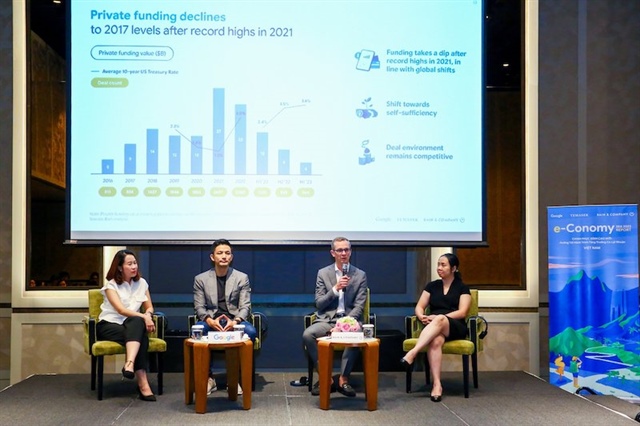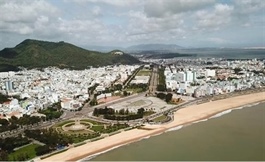Hanoi among cities driving Vietnam's digital economy growth
Hanoi among cities driving Vietnam's digital economy growth
Vietnam continues to be the fastest growing digital economy in Southeast Asia for the second year in a row (2022 & 2023).
Hanoi, Ho Chi Minh City, and Danang are the top three metro cities leading digital participation in Vietnam and will contribute significantly to the growing digital economy in Vietnam in the coming years, experts said at the e-Conomy SEA 2023 report press conference held in Ho Chi Minh City on November 6.

An overview of the press conference. Photos: Google |
The contribution of Hanoi and these cities to the growth of the digital economy has been built and realized through prioritized goals in terms of infrastructure, core resources, and cooperation among relevant parties, Andrea Campagnoli, Office Head and Founding Partner of Bain & Company Vietnam, told The Hanoi Times.
He highlighted that Vietnam is the fastest-growing digital economy in Southeast Asia (SEA) for the second consecutive year (2022 & 2023), and is projected to maintain this position in 2025.
Vietnam's gross merchandise volume (GMV) is expected to grow at a compound annual growth rate (CAGR) of 20% from US$30 billion in 2023 to US$45 billion in 2025, according to the report.
From 2023 to 2025, GMV growth will be driven by e-commerce and online travel. E-commerce in Vietnam grew by 11% from 2022 to 2023 and is predicted to grow at a CAGR of 22% from 2023 to 2025, reaching a GMV of nearly US$24 billion in 2025.

The 8th Southeast Asia Digital Economy Report |
The 8th Southeast Asia Digital Economy Report, entitled "Reaching new heights: Navigating the Path to Profitable Growth," released by Google, Temasek and Bain & Company, updated the digital economy trends of six countries in SEA, including Indonesia, Malaysia, the Philippines, Singapore, Thailand and Vietnam.
Speaking at the event, Marc Woo, Managing Director of Google Vietnam, said that while digital inclusion has progressed in Vietnam and other Southeast Asian countries in recent years, consumers outside of metropolitan areas are at risk of facing a widening digital economic divide in terms of digital participation, active involvement in the digital economy through consumption of products or services in different sectors.
However, he added, the gaps are widening beyond metro areas, and rural areas are particularly vulnerable due to challenging unit economics. Addressing these gaps is the collective responsibility of all stakeholders in the digital economy.

Speakers attend the event. |
"In addition, removing barriers such as supply and security issues can also improve the participation of non-high-value users and enable Vietnam's digital economy to achieve its growth ambitions," he stressed.
High-value users continue to drive sustainable unit economics, but significant growth headroom lies in increasing digital participation, Marc Woo noted.
He added that over 70% of transaction value in the digital economy is generated by the top 30% of SEA spenders. Non-high-value users also represent a significant opportunity.
In Vietnam, high-value users spend 5.4 times more than non-high-value users. While high-value users are more likely to increase their spending over time, non-high-value users also represent a growth opportunity. As consumer demand continues to grow, the majority of non-high-value users have an appetite to increase their online spending if more trust can be built and barriers such as the need to touch and feel products can be addressed.
Andrea Campagnoli of Bain & Company Vietnam said: "Vietnam has been the fastest growing economy in Southeast Asia in recent years, despite the recent slowdown. And remarkably, the country is showing positive year-on-year growth in investment volumes for the first half of 2023, which is a testament to investors' belief in the country's long-term potential," he said.
Despite global macroeconomic headwinds, the region's GMV continues its upward trajectory and is expected to reach $218 billion, up 11% year-on-year. SEA's digital economy revenues will reach $100 billion this year, according to the report.
This is the first year that the report includes revenue figures in addition to GMV, providing a more detailed look at how companies have accelerated growth amid macroeconomic headwinds. It also takes a deep dive into the opportunities for increased digital participation to unlock further growth in the region's digital decade.
|
Full recovery in the travel sector is expected this year, driven primarily by sharp growth in domestic travel. Online travel grew by 82% from 2022 to 2023, and will continue to grow at a CAGR of 21% from 2023 to 2025, reaching a GMV of nearly $7 billion. The recovery in the number of domestic and international routes have enabled this uptick, despite the delayed return of Chinese tourists. Other key sectors that continue to grow and help drive Vietnam's digital economy include transport & food and online media. The GMV of transport and food grew by 10% from 2022 to 2023 and are projected to grow at 16% CAGR from 2023 to 2025 and is forecasted to reach $4 billion in 2025. Online media sector in Vietnam grew by 11% from 2022 to 2023, and is projected to reach a GMV of $7 billion by 2025 with a CAGR of 15% from 2023 to 2025. |























